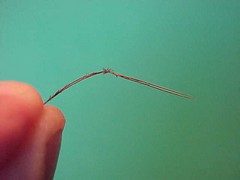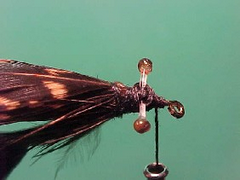Free fly tying
{{start}}
{{end}}
{{+1}}Loop method of dubbing{{-1}}
{{start}}
The key elements of the dubbing loop method of dubbing are: Dubbing material is trapped inside a loop that is twisted into a rope. This is the best method for dubbing coarse materials such as SLF or stands of material such as hair etc..{{end}}
{{+1}}Proportions – dry fly{{-1}}
{{start}}
The physics of dry flies are quite simple either they rely on buoyancy (displacement) to simply float or they rely on the materials used to be light and resist water penetration and consequently to be supported on the surface tension of the water.{{end}}
{{+1}}Spun bodies – deer hair{{-1}}
{{start}}
It doesn’t matter if the spun deer hair body you are making is on a size # 2/0 Dahlberg Diver or a size # 12 Adams Irresistible the method of building the body is the same. The method for building a spun deer hair body for a right handed fly tier is set out below.{{end}}
{{+1}}Hot legs – deerhair{{-1}}
{{start}}
First brought to my attention by members of the Jassid Fly Fishing Club in Tasmania this technique was found on the Sexyloops website. For those of us that subscribe to the impressionistic side of fly tying this is a great technique of representing legs and feelers on flies. It an extension of the loop dubbing technique that uses deer hair as the dubbing material rather than the traditional softer wool, fur and synthetic dubbing materials. Working with deer hair in this way to make hot legs can be a bit messy but its well worth the effort and the clean up.{{end}}
{{+1}}Brush type wings – deerhair{{-1}}
{{start}}
A very popular technique for tying emerger flies. More recently brushes have been tied from CDC as well as deer hair and both work well. The secret of course is that both materials float well. Deer hair brush type wings are a very effective way of adding flotation to a fly just where you want it. As long as you have the buoyancy of the wing and the weight equation of the fly correct the wing will hold the fly in the surface film with the business end right in the trouts face.{{end}}
{{+1}}Adding weight to a fly{{-1}}
{{start}}
In most cases if your weighting a fly place the weight as far forward as possible. By placing the weight forward the swimming action of the fly is enhanced. The various techniques for weighting a fly can be used either alone or in conjunction with other weighting techniques when additional weight is required.{{end}}
{{+1}}Weed guards – bass{{-1}}
{{start}}
There are times when you just have to fish right into structure but every time you do you get hooked up. This is particularly so when fishing for Saratoga amongst lily pads, Barramundi amongst the mangroves and Mangrove Jacks and Bass amongst the snags. At those times to increase fishing time and save a lot of frustration I suggest you use flies with double weed guards. Forget about single weed guards they are almost useless and only cut down the snag rate a little if at all.{{end}}

{{+1}}Knotted pheasant tail barbule legs{{-1}}
{{start}}
Knotting pheasant tail barbules (or fibers as barbules are also known) is a great way to make realistic eyes for flies. The procedure is simple yet a bit finicky particularly if you have big clumsy finger like me.{{end}}

{{+1}}Eyes – monofilament eyes{{-1}}
{{start}}
Most recipes use the term "figure of eight wraps of thread" when describing how to tie in burnt monofilament eyes and other eyes that have two eye balls connected by a stem. Technically consecutive single wraps of thread as described in steps "E" and above in "F" below are called figure of eight wraps. From experienced I have found that its better to use the process below rather than consecutive individual figure of eight wraps.{{end}}

{{+1}}Monofilament eyes{{-1}}
{{start}}
Whilst there are many ways of adding eyes to a fly one easy way to add a little more realism to a fly is to include a set of burnt monofilament eyes in the dressing of the fly.{{end}}













